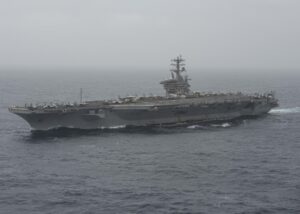The Navy is considering whether to extend the service lives of the oldest Nimitz-class aircraft carriers, a service official said Thursday.
“We’ve got 40 more years of Nimitz [class] life but Nimitz herself is coming up to potentially an end of life cycle at the end of this [Future Years Defense Program]. But she has capability beyond that point. So we’re looking at where that capability sits, from a timeframe perspective,” Program Executive officer for Aircraft Carrier Rear Adm. James Downey said during the American Society of Naval Engineers’ virtual Fleet Maintenance and Modernization Symposium.

Downey added that “generally, the math takes you to the 52 or 55 years, so we have that issue we’re going through.”
He noted the service is exploring extensions while analyzing how to balance the specific shipyards and dry docks where the extension work can be done with scheduled upcoming docking availabilities and refueling and complex overhauls.
“We’re looking to deconflict that at the beginning of the next FYDP as well.”
Downey characterized discussions on carrier extensions as “significant” for the USS Nimitz (CVN-68) itself in particular. He said they will see what the Navy and Defense Department works out in the next one to two years on this plan, with potential adjustments to near-term docking plans.
He underscored the ships don’t exist by themselves, but extensions also impact tens of ships on each side of extensions and decommissioning times.
“These ships don’t go by themselves. That also affects another 30-plus ships on each side of that – ships with her, ships with the next strike group. So some pretty significant considerations there. And then it also affects how many – when we pull the sailors off and how we affect that manning profile for the whole ship and certainly the nuclear plant. “
Downey noted the Nimitz-class carriers were originally designed in the 1960s for an expected 30-year service life but now are on track for 50-55 years at full capability.
“That is not a diminished rate whatsoever…we’ve got significant network efforts going on, the self-defense systems going on, missile systems going on. It’s interesting to look at the increased modernization, including [F-35 Joint Strike Fighter integration] and others and see that design has succeeded without significant hull, mechanical, electric modifications over those 50 years, other than the overhaul.”
Downey said this is different from other ship classes he has personally experienced over time.
“So a great design that has really enabled the modernization for nearly double of what the plan of the class was,” he added.
The Defense Department and Navy have not yet submitted the FY ’21 30-year shipbuilding plan to Congress, but the last plan from FY ’20 showed the carrier inventory decreasing from 11 in 2024 to 10 in 2025, when the CVN-68 was planned to be retired.
CVN-78 was commissioned in 1975 and had its maiden deployment in 1976. It stayed in service for about 45 years. If Nimitz is extended from 50 to 52 or 55 years, it would operate into the late 2020s and increase the planned overall carrier count as new Ford-class carriers come into service.